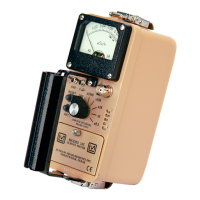
Do you have a question about the LUDLUM 14C and is the answer not in the manual?
| Brand | LUDLUM |
|---|---|
| Model | 14C |
| Category | Measuring Instruments |
| Language | English |
Instructions for removing the instrument and accessories from the carton and verifying contents.
Step-by-step guide for correctly installing 'D' cell batteries into the instrument.
Procedure for securely connecting external detectors to the survey meter using cables.
Method for checking the battery charge status using the instrument's BAT button.
Procedure to verify the instrument's functionality, including audio and meter response.
Guidance on interpreting readings displayed on different types of meter faces.
Recommended daily or pre-use check to ensure instrument and detector are operating correctly.
Description of the six-position switch used for selecting measurement ranges.
Functionality of the switch that controls the audio output clicks or tones.
Explanation of the toggle switch for adjusting meter response time (Fast/Slow).
Function of the pushbutton used to reset the meter needle to zero.
How to use the button for a visual check of the battery charge status.
Location and purpose of recessed potentiometers for range calibration.
Specifies acceptable operating temperature, humidity, and altitude ranges.
Explanation of safety symbols and cautions marked on the instrument.
Guidelines for safely cleaning the instrument's exterior and performing basic maintenance.
General notes on measuring high voltage and recommended recalibration intervals.
Process for setting the optimal operating point for detector sensitivity and stability.
Procedure to adjust controls for proper full-scale indication at a specific R/hr.
Steps for calibrating each measurement range using a calibrated gamma field.
Basic maintenance involves keeping the instrument clean and checking batteries.
Information on when recalibration is recommended and available services.
Guidance on removing batteries for storage and cleaning battery contacts.
Common symptoms and potential solutions for electronic issues with detectors.
Specific checks for issues related to Geiger-Mueller (GM) detector functionality.
Specific checks for issues related to scintillator detector performance.
Describes how external and internal detector pulses are received by the instrument.
Explains the function of the amplifier circuit in boosting detector signals.
Details the process of discriminating between valid signals and noise.
Explains how detector pulses are converted into audible clicks or tones.
Describes the circuitry that drives the analog meter movement.
Details the generation and regulation of the high voltage for detectors.
Explains the circuit that triggers an alarm when battery voltage is low.
List of main assembly and board part numbers for the survey meter.
List of capacitor components with their values, voltage ratings, and part numbers.
List of transistor components with their part numbers.
List of integrated circuits with their part numbers.
List of potentiometer components with their values and part numbers.
List of resistor components with their values, tolerance, and part numbers.
List of connector types with their part numbers.
List of inductor components with their values and part numbers.
List of various miscellaneous components and their part numbers.